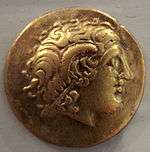Veliocasses
The Veliocasses (or Velocasses) were a Belgic or Gallic tribe of the La Tène and Roman periods, dwelling in the south of modern Seine-Maritime and in the north of Eure.[1]
Name
They are mentioned as Veliocasses by Caesar (mid-1st c. BC) and Pliny (1st c. AD),[2][3] as Ou̓éliokásioi (Οὐέλιοκάσιοι; var. οὐενελιοάσιοι) by Ptolemy (2nd c. AD),[4] and as Velocasses by Orosius (early 5th c. AD).[5][6]
The meaning of the name Veliocasses is uncertain. The first part is the Gaulish root uelio-, which could either stem from Proto-Celtic *wēliyo ('modest'; compare with Old Irish féle and Welsh gwyledd 'honestas'), or from Proto-Celtic *wello- ('better'; compare with Welsh gwell 'better').[7][8][9] The second etymology is semantically more probable in a tribal name,[7] but the unknown length of the vowel e in uelio- makes it difficult to conclude on its origin with certainty.[9] The meaning of the element -casses is likewise unclear. It possibly means 'hair, hairstyle', perhaps a particular warrior coiffure, or 'tin, bronze (helmet?)'.[10][8]
The county of Vexin, attested as pagus Veliocassinus in 617 (Vilcassinum in 1092, Vulesin in 1118), is named after the Belgic tribe.[11]
Geography
The territory of the Veliocasses was located in the north and, limited extent, also in the south of the lower reaches of the Sequana (Seine) river.[1] Their territory was situated between that of the Caletes and Bellovaci. Wooded heights constituted a natural frontier with the Bellovaci, where the latter dominated.[12]
During the pre-Roman period, their capital was probably the oppidum of Camp de Calidou (near Caudebec), named Rotomagu after the reign of Augustus.[1]
History
During the Gallic Wars (58–50 BC), the Veliocasses participated in the tribal coalition of the Belgae that resisted the Romans in 57 BCE. In 52 they raised 3,000 men to support Vercingetorix, and fought alongside the Bellovaci in the final rebellion against Roman hegemony.
Culture
As for the neighbouring Calates, whether the Veliocasses should be regarded as Gallic or Belgic is debatable.[12]
References
- Polfer 2006.
- Caesar. Commentarii de Bello Gallico, 2:4; 8:7
- Pliny. Naturalis Historia, 4:107
- Ptolemy. Geōgraphikḕ Hyphḗgēsis, 2:8:7
- Orosius. Historiae Adversus Paganos, 6:7:14
- Falileyev 2010, entry 2399.
- Delamarre 2003, p. 311.
- Busse 2006, p. 199.
- Matasović 2009, pp. 410.
- Delamarre 2003, pp. 109–110.
- Roblin 1976, pp. 4, 28.
- Wightman 1985, p. 27.
Bibliography
- Busse, Peter E. (2006). "Belgae". In Koch, John T. (ed.). Celtic Culture: A Historical Encyclopedia. ABC-CLIO. pp. 195–200. ISBN 978-1-85109-440-0.
- Delamarre, Xavier (2003). Dictionnaire de la langue gauloise: Une approche linguistique du vieux-celtique continental (in French). Errance. ISBN 9782877723695.CS1 maint: ref=harv (link)
- Falileyev, Alexander (2010). Dictionary of Continental Celtic Place-names: A Celtic Companion to the Barrington Atlas of the Greek and Roman World. CMCS. ISBN 978-0955718236.
- Matasović, Ranko (2009). Etymological Dictionary of Proto-Celtic. Brill. ISBN 9789004173361.CS1 maint: ref=harv (link)
- Polfer, Michel (2006). "Veliocasses". Brill’s New Pauly.CS1 maint: ref=harv (link)
- Roblin, Michel (1976). "Petromanlalum, Saint-Clair et le Vexin". Journal des Savants. 1 (1): 3–31. doi:10.3406/jds.1976.1332.
- Wightman, Edith M. (1985). Gallia Belgica. University of California Press. ISBN 978-0-520-05297-0.CS1 maint: ref=harv (link)
